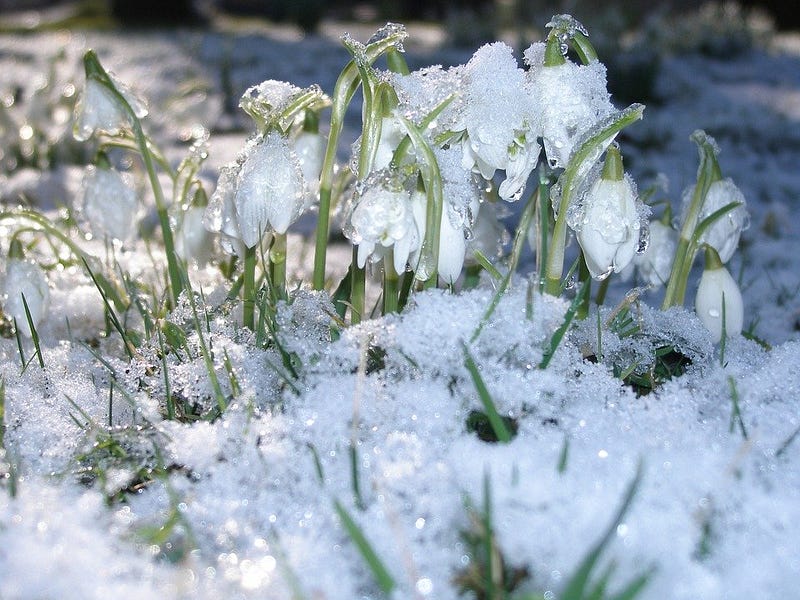Zombies in the snow: reviving ancient pathogens
By Amanda Zavala, Cell & Molecular Biology, 2020

2016, Siberia. The summer was unusually warm, and the permafrost began to melt, thawing reindeer carcasses that were buried in the ice 75 years ago. That summer, a young boy, and over 2,000 reindeer, died of anthrax infection — the first Siberian outbreak in 75 years.
Permafrost is a layer of soil and ice that remains frozen year-round, covering almost a quarter of the Northern Hemisphere. In northern Siberia, the permafrost can be up to 1,500 meters thick, with fluctuations of about 50 centimeters depending on the season. In the summer of 2016, temperatures in Siberia reached a record high, and thawed an unusually large amount of the permafrost. This thawing released B. anthracis, or anthrax bacteria, which had lain dormant in frozen reindeer carcasses, into the water supply. As early as 2011, Russian scientists predicted this outbreak based on the steadily rising global temperature since the 1970s, and the correlated thawing of permafrost. Some experts theorize that, as the global temperature continues to increase, more ancient pathogens will emerge and become infectious again. Media reports on the phenomenon have coined the term “zombie pathogens” to describe the potential risk of these dormant microbes.
In the summer of 2016, temperatures in Siberia reached a record high, and thawed an unusually large amount of the permafrost.
Anthrax is not the only microbe that can be revived from frozen samples. Once thawed, 32,000-year-old bacteria, found in a frozen pond in Alaska, were metabolically active. Ancient viruses were also recovered from Siberian ice samples. These microbes, which do not infect humans, were so old that they had not been seen since wooly mammoths were alive. Not all microbes are able to survive cold temperatures for long periods of time, but the microbes that developed to be especially hardy could survive. Under harsh conditions, cold-resistant bacteria, like the C. pleistocenium identified in Alaska, form tough spores that can survive for over a century. Modern spore-forming bacteria include organisms that cause tetanus and botulism. The viruses that, thus far, have been recovered from permafrost only infect amoebas, but experts suggest that viruses capable of infecting humans could be lying dormant as well.
Among all the other concerns associated with climate change, zombie pathogens are one not often considered. Fortunately, despite media concerns, the actual risk to humans seems low. Deliberate attempts to revive virus particles in the lab were unsuccessful in the past 50 years. On multiple occasions, scientists took samples from mummified bodies to try to culture everything from influenza to smallpox; nobody was able to recreate infectious particles from the recovered genetic material. If viruses cannot be revived under rigorous laboratory conditions, it seems unlikely that an outbreak could occur due to naturally thawing permafrost. The viruses that were recovered from ancient ice samples all belong to a class called giant viruses. This class contains viruses that are larger than the typical virus, and that use extra genes to encode a thick protein shell, called a capsid, which provides protection similar to bacterial spores. No discovered giant viruses are capable of infecting humans.
Fortunately, despite media concerns, the actual risk to humans seems low. Deliberate attempts to revive virus particles in the lab were unsuccessful in the past 50 years.
And the anthrax outbreak? While the Russian government attributed this outbreak to spores from reindeer carcasses, anthrax bacteria is found naturally in soil, and it is not impossible for the bacteria to enter the water supply in other ways. Revival from thawing permafrost is an unusual cause of outbreak, and scientists currently do not understand the phenomenon well enough to confidently predict how the potential frozen spores respond to continued rising temperatures. Many of the most concerning infectious diseases that could make a comeback are not capable of surviving when frozen because they are designed to survive and replicate at body temperature. Increasing temperatures will lead to a wide variety of global problems, but the risk of zombie pathogens emerging from frozen graves to infect us with long-forgotten diseases seems only slightly more likely than a classic zombie apocalypse.
